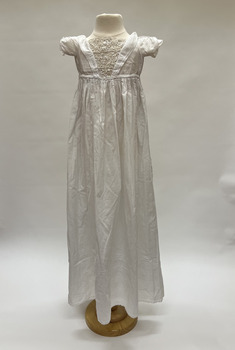Historical information
In the early 19th century, infant baptismal gowns were modelled on dresses worn by adult women. Gowns were typically made of fine white linen or cotton, and often trimmed with tucks, lace, whitework embroidery, and other handwork. The Kew Historical Society's collection includes over fifteen christening gowns dating from the 19th and 20th centuries.
Physical description
Very long, white cotton christening gown. The bodice is distinguished by an intricate panel of handmade lace that forms a semi-circle at the neck. On either side of the lace insert are folded lapels, each bordered with lace. The short sleeves are constructed of two overlapping pieces of fabric. Below the waist the fabric is pleated to allow for the large amount of fabric in the skirt to flare outwards. The extraordinary detail within the gown is extended to the lower section of the skirt where the maker has created five pleated bands, each comprising four layers. The hem also features a band of lace.

